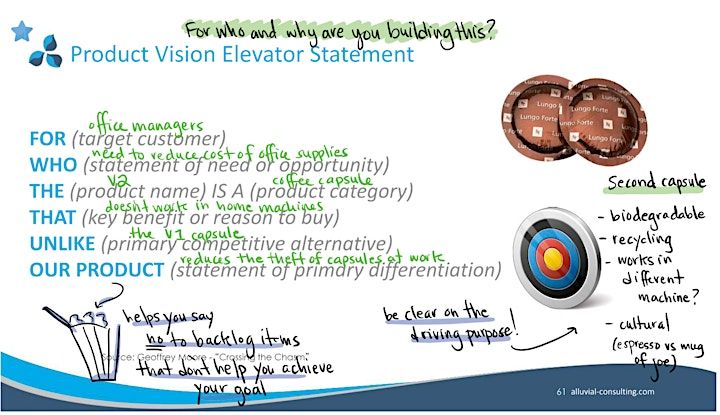
About this Event
If you are involved in developing user-centered products, having a clear Product Goal and Success Metrics is crucial. This course focuses on techniques for creating and communicating a Product Goal to users, stakeholders and the delivery team. From there, understand how the Product Backlog is the vehicle for achieving the Product Goal.
Using real world examples and exercises to understand what makes a good Product Goal and what doesn’t, that can then be applied in your work.

What is a Product Goal?
The Product Goal describes a future state of the product which can serve as a target for the Delivery Team to plan against. The Product Backlog emerges to define “what” will fulfill the Product Goal. The Product Goal is the long-term objective for the Scrum Team.
“ A product is a vehicle to deliver value. It has a clear boundary, known stakeholders, well-defined users or customers. A product could be a service, a physical product, or something more abstract.”
What are Success Metrics?
Success Metrics for product development are empirical data points that a team and organization can track to gauge the product’s overall success. These could be based on user adoption, churn rate, revenue per customer, number of active users and can be characterized as OKRs (Objectives & Key Results) or KPIs (Key Performance Indicators).
Learning Objectives
- Understand the difference between Product versus a Project
- What is a Product Goal in the Scrum Framework and why is there only one
- How to create a Product Goal and the value of doing so
- How to and the importance of switching from an output to an outcome driven approach
- Know how to measure success in outcomes, through value driven metrics
- Learn the difference between OKRs (Objectives and Key Results) and KPIs (Key Performance Indicators)
- How iterative delivery is measured against the incremental changes in outcome metrics
- The accountabilities of the Product Owner and Scrum Team in achieving the Product Goal
- Understand that the purpose of iterative delivery is to learn from the impact of the features and how the metrics should drive changes to the Product Backlog and potentially abandoning or changing the Product Goal
What you will get
- 2.5 hours of engaging teaching by a deeply experienced practitioner and trainer
- Slides and templates to help you put into practice what you have learned
- Earn 3 Scrum Education Units (of the 20 required), under the “Learning” category, towards your Scrum Alliance certification renewal requirement. https://www.scrumalliance.org/get-certified/scrum-education-units
- A 1-hour follow up ask-me-anything session to ask specific questions after you’ve had time to apply what you’ve learned
Recommended Pre-requisite
- Certified Scrum Master or Certified Scrum Product Owner
- One year of practical experience using Scrum
About the Trainer
Petra Skapa has been leading Agile transformations for over 15 years across North America, Europe, the UK and India. As Gap Inc’s Chief Agilist, and as a Scrum Master, Iteration Manager, Agile Project Manager, and Senior Consultant for a variety of global organizations, Petra brings an invaluable breadth of real- world experience to her work.
As a Certified Scrum Trainer, Petra has taught thousands of students in Certified Scrum Master and Certified Scrum Product Owner classes. She has helped teams and executives leverage Agile and Scrum at companies across multiple industries, including aviation, retail, medical, leasing, insurance, telecom, government and Ivy League universities.

Event Venue
Online
CAD 199.00
